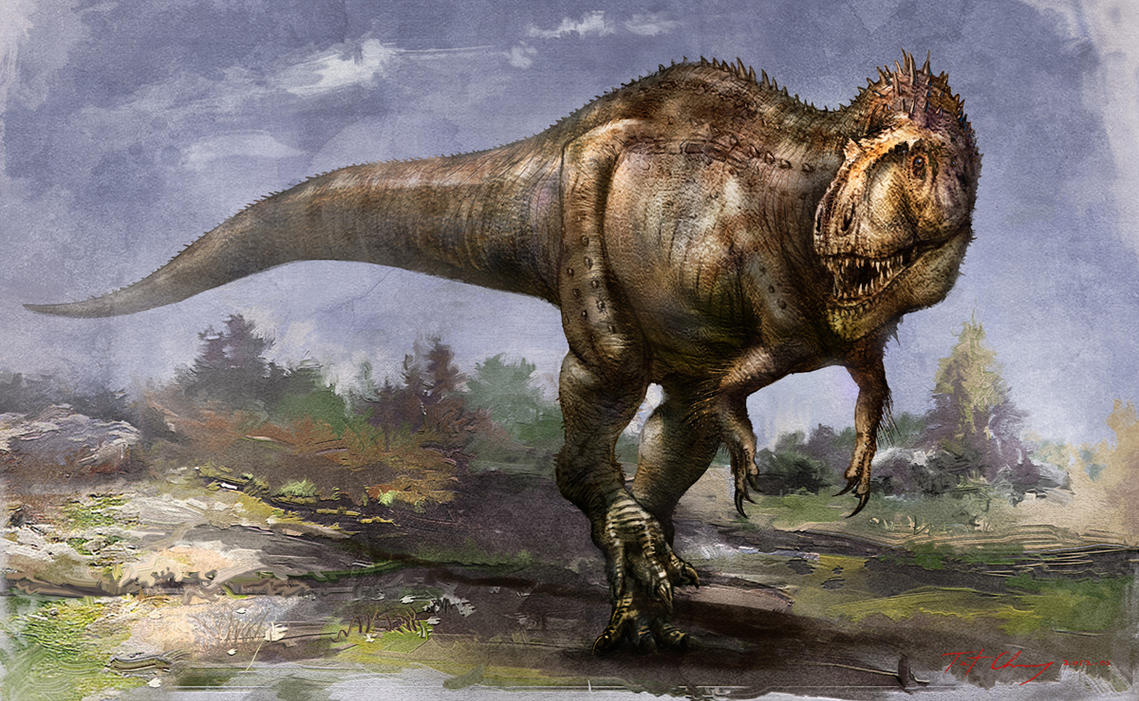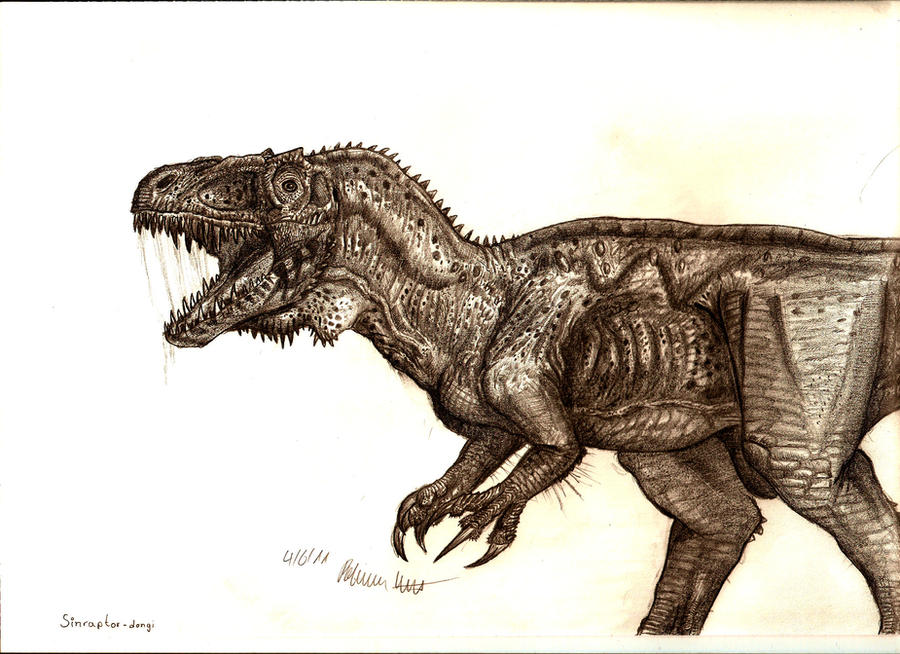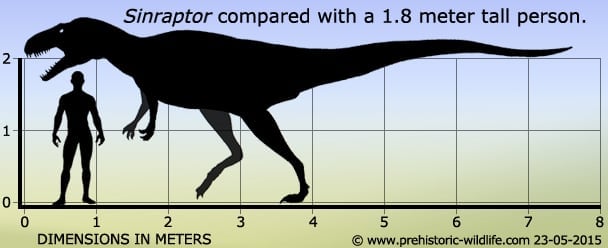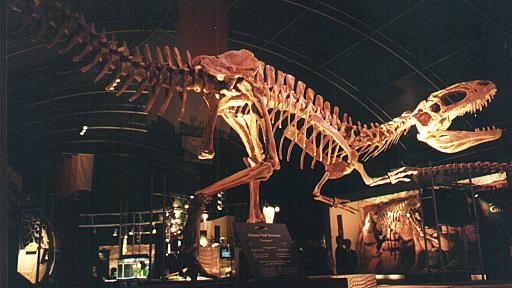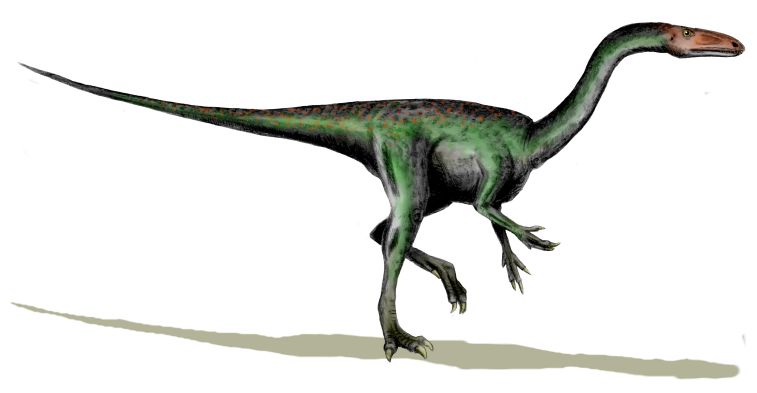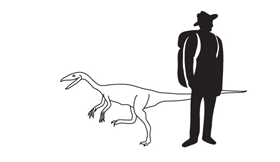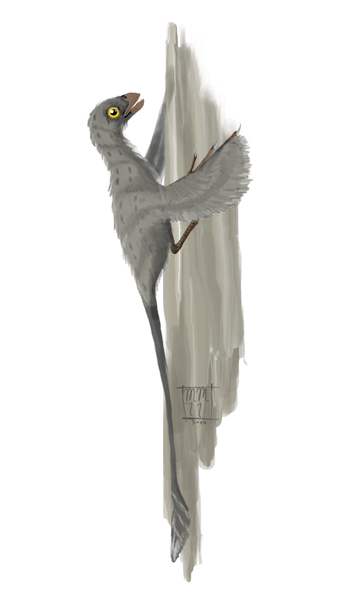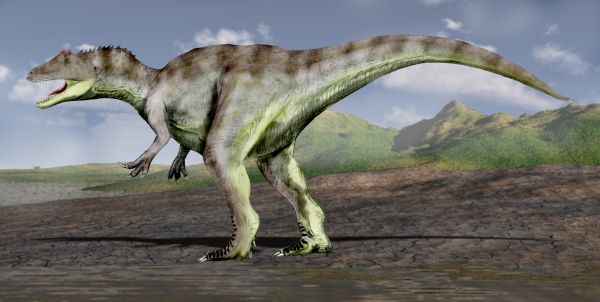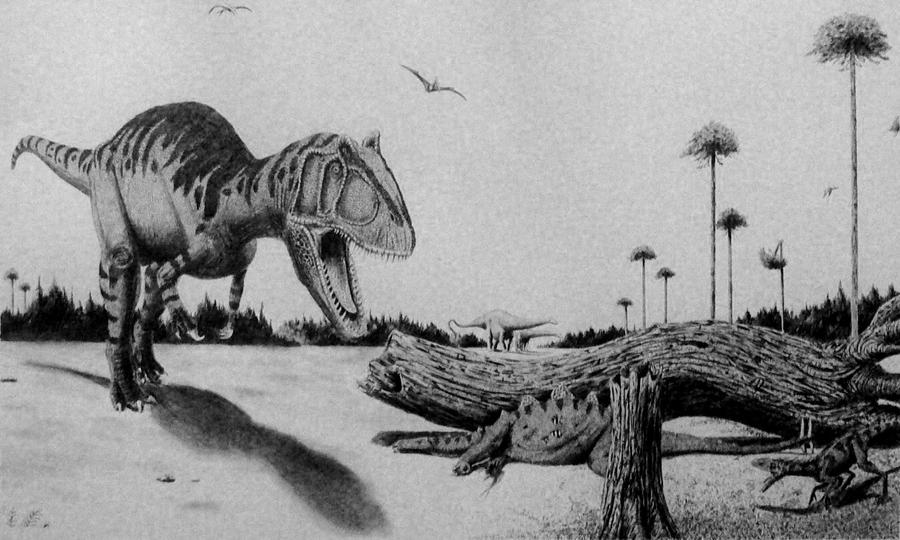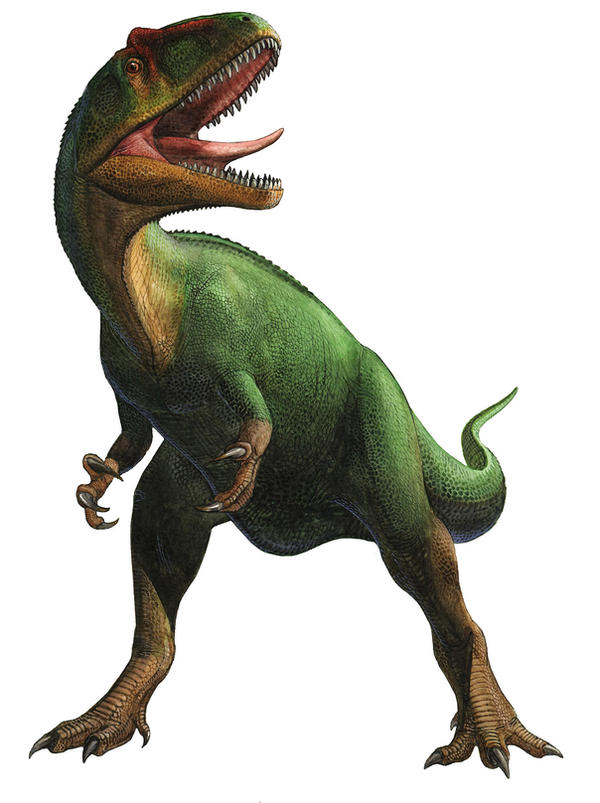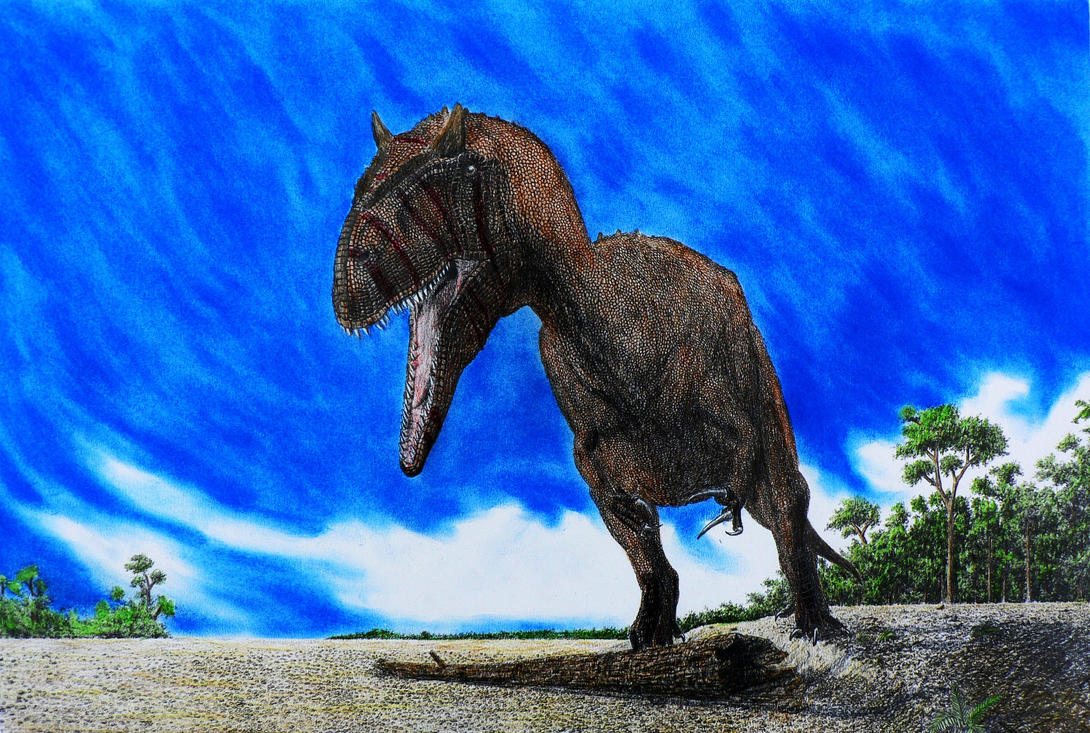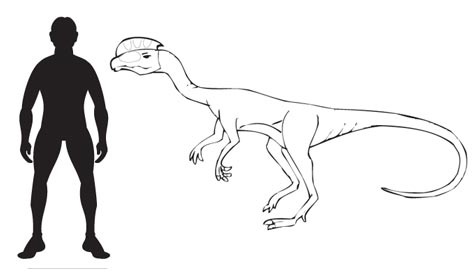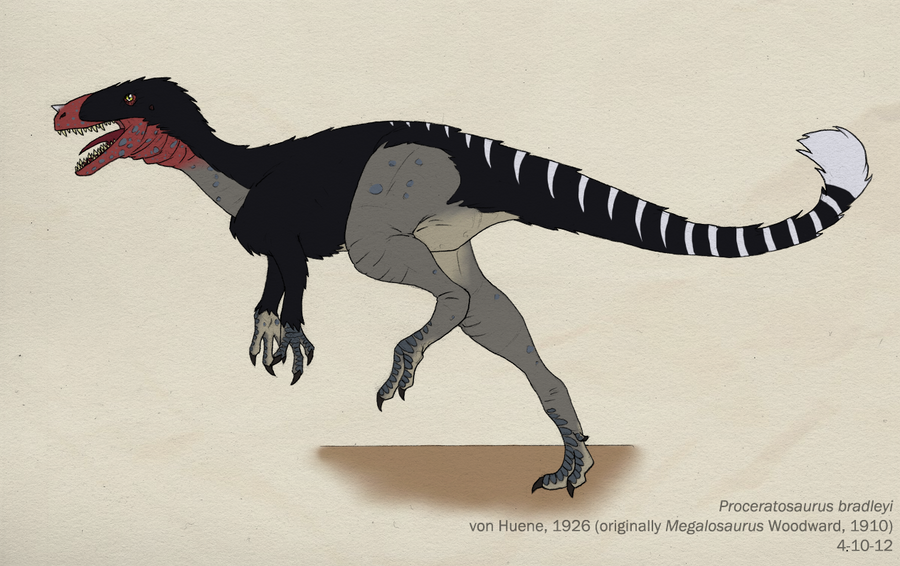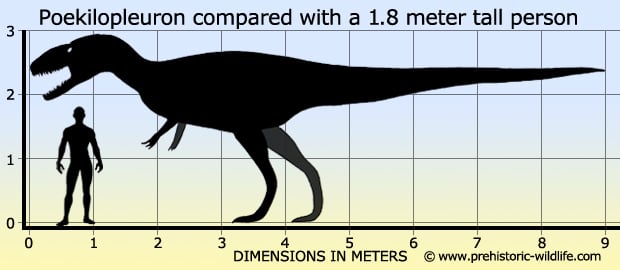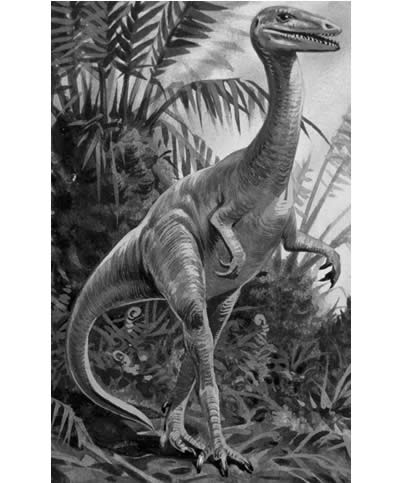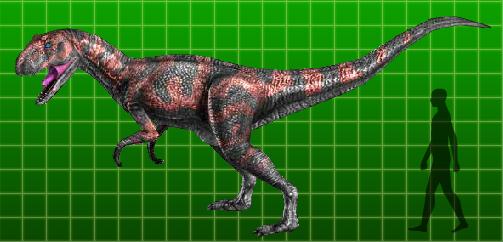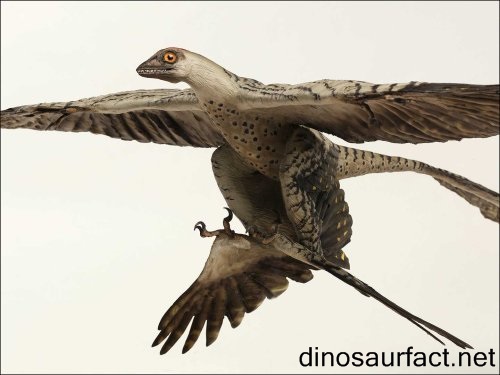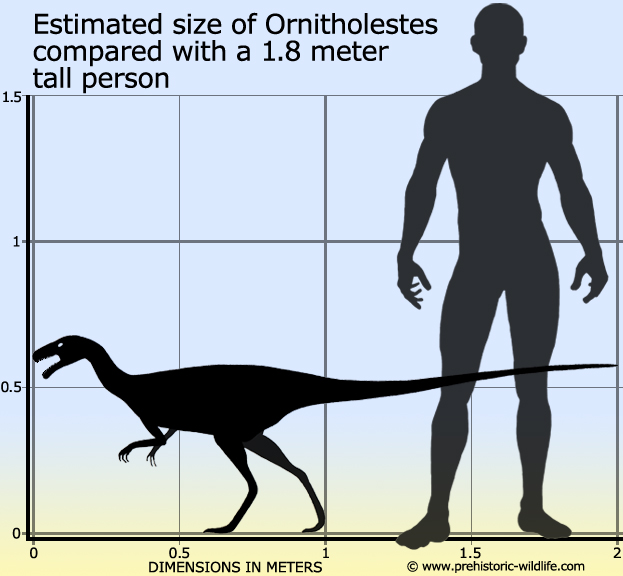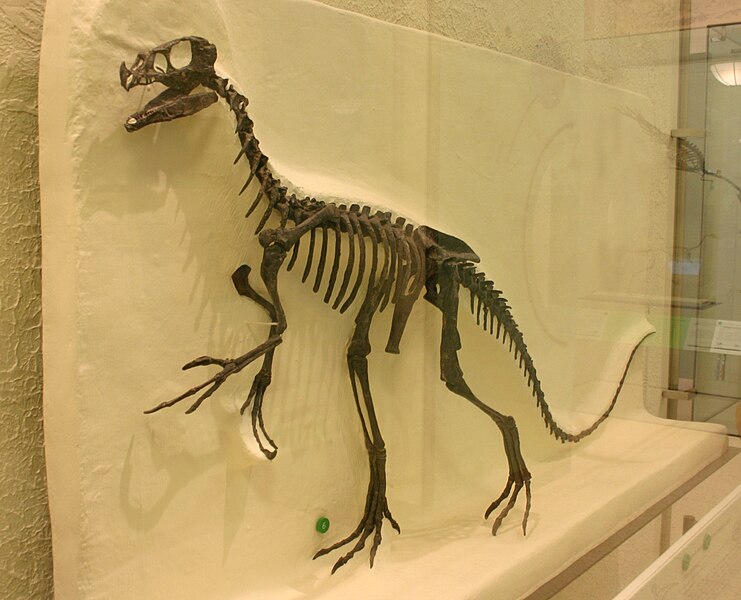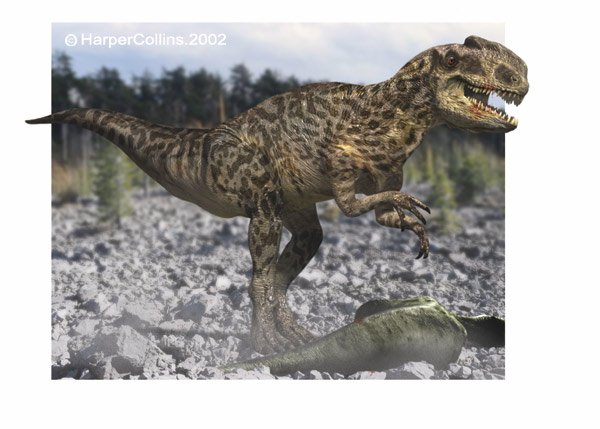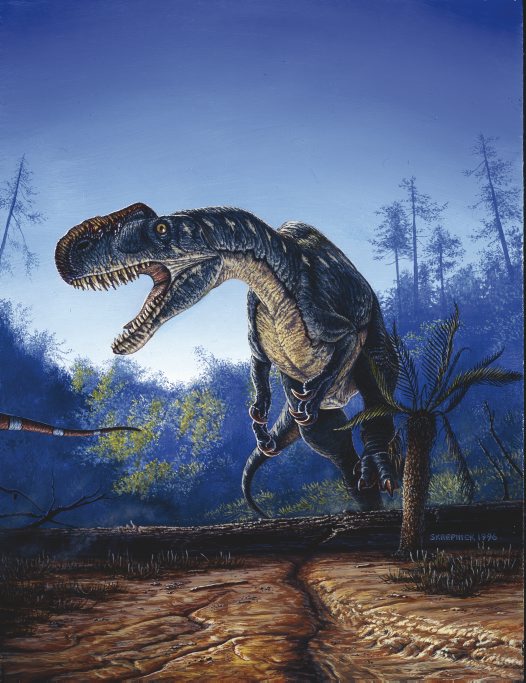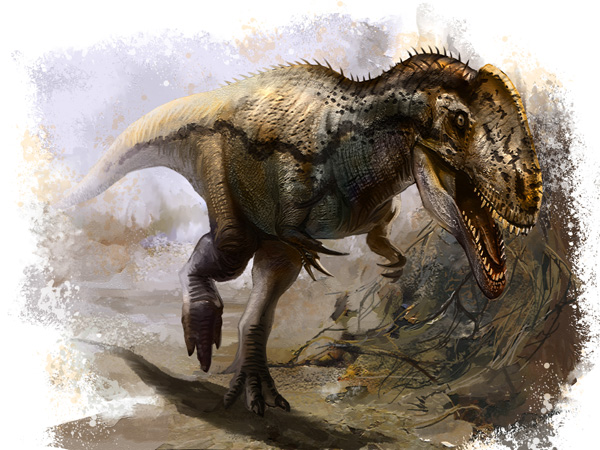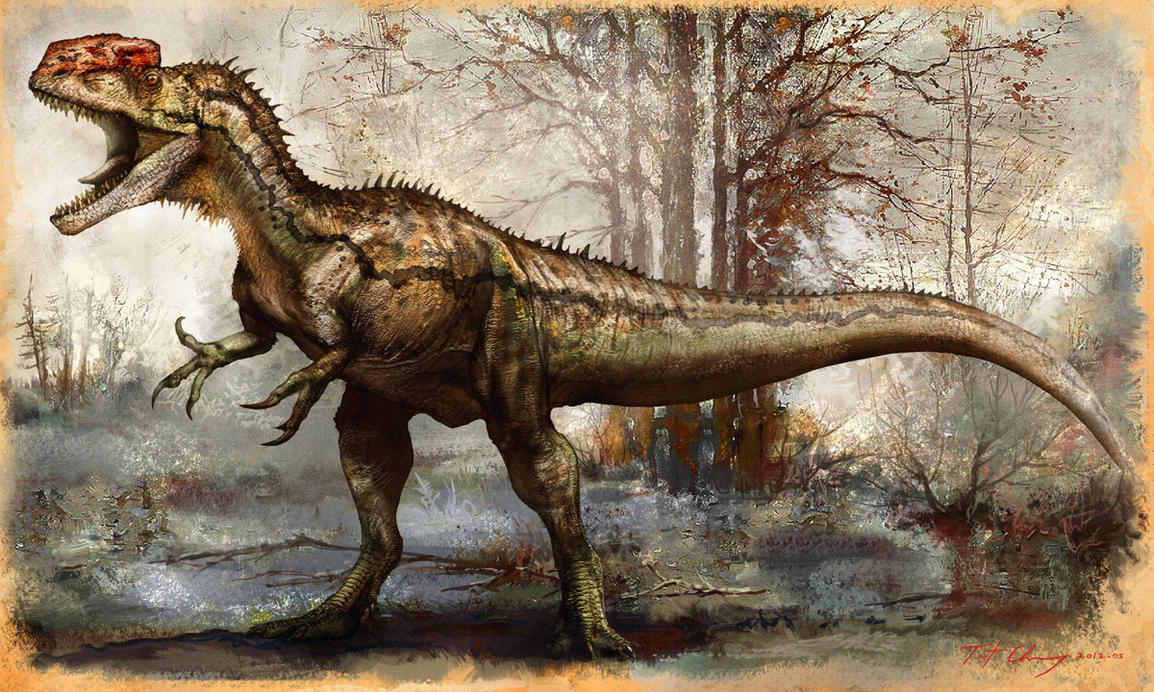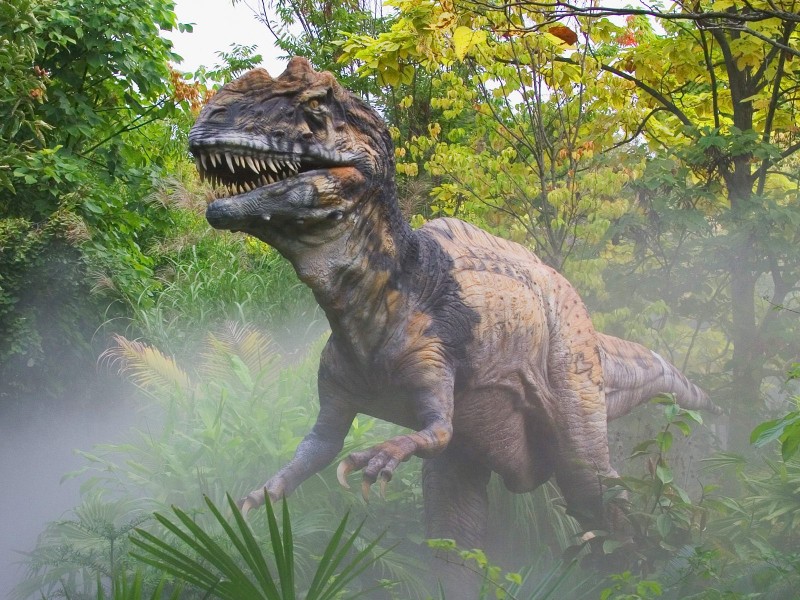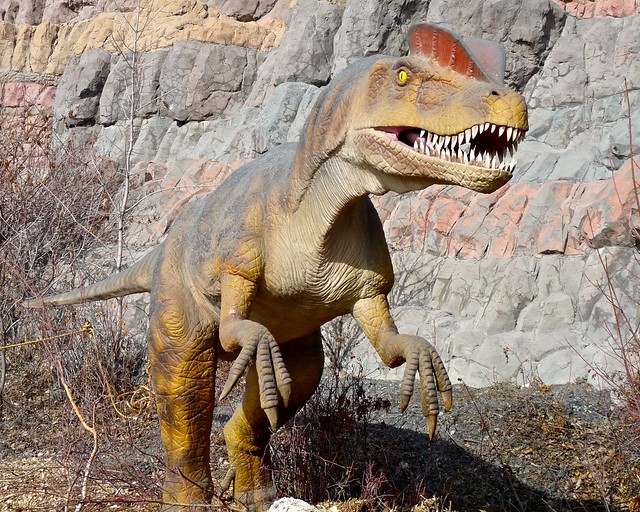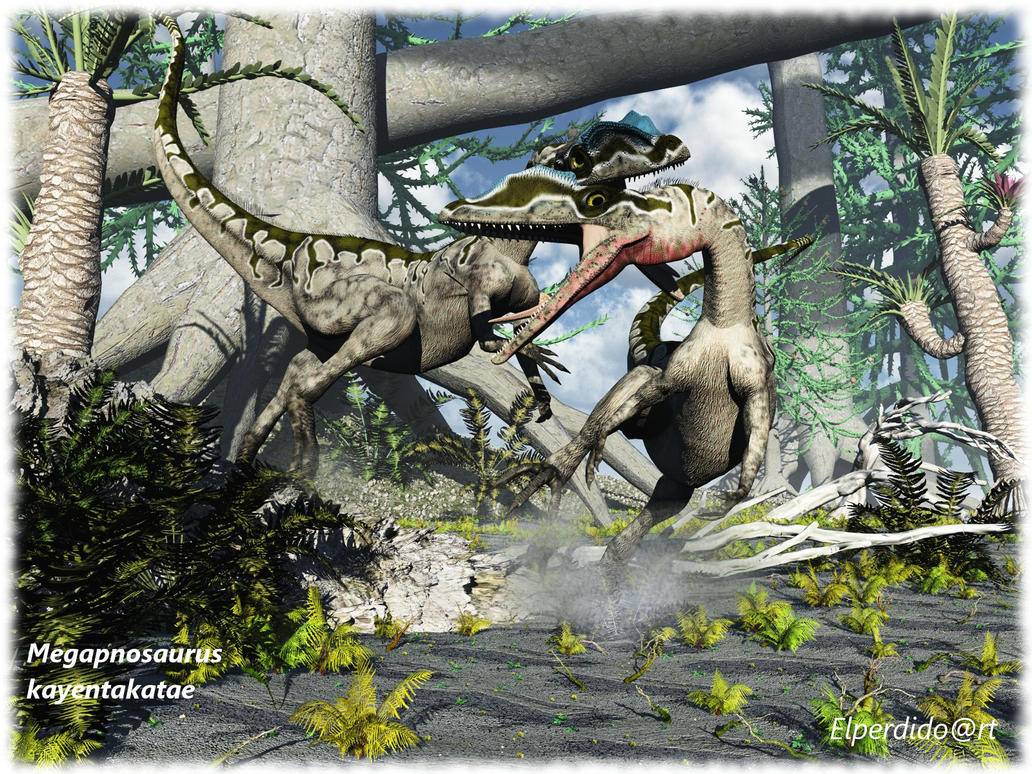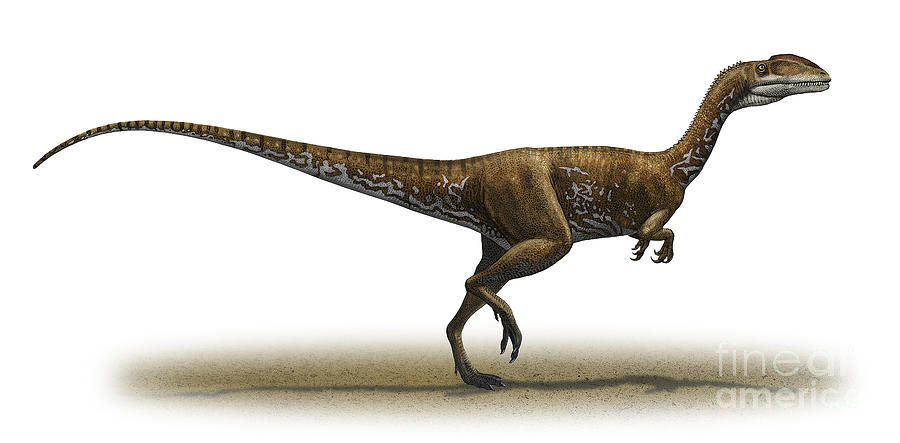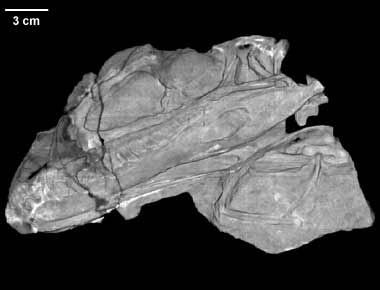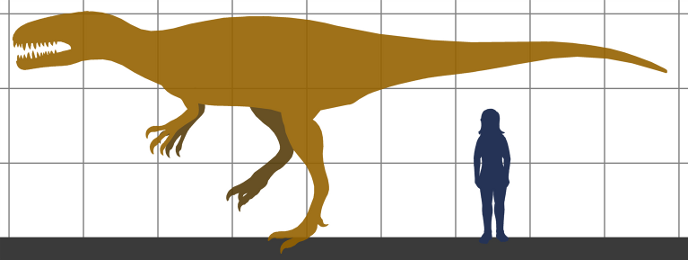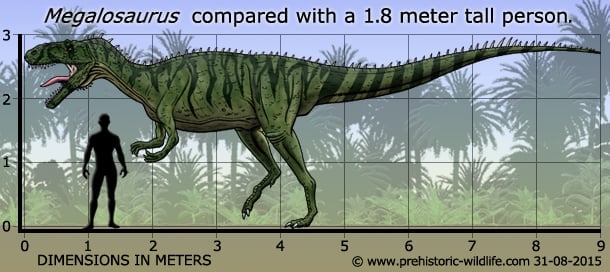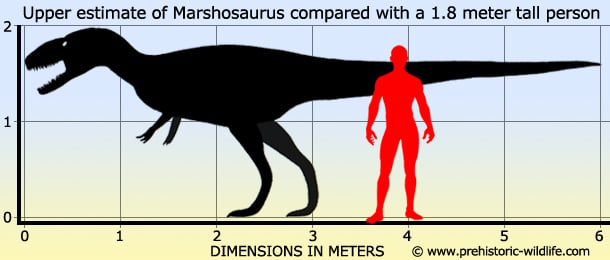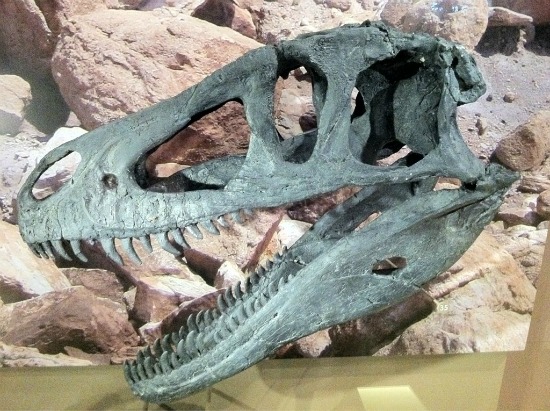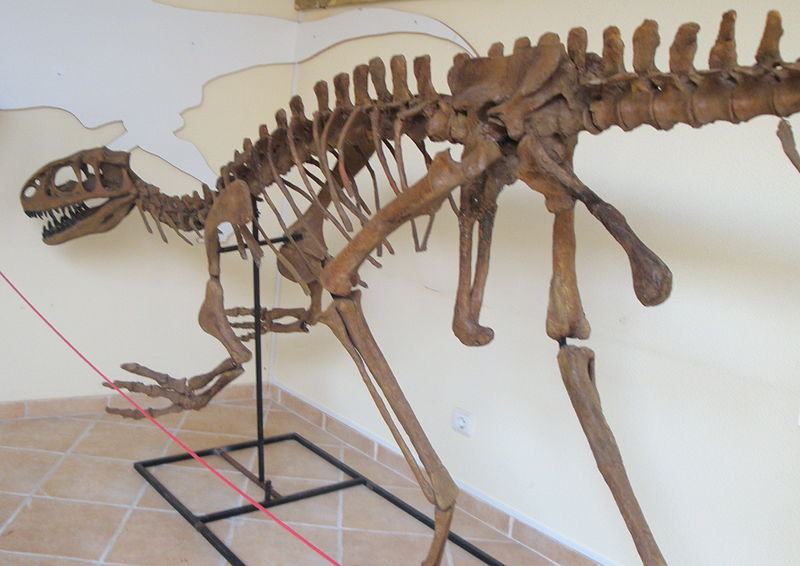[Recent Entries][Archive][Friends][User Info]
Below are 20 entries, after skipping 20 most recent ones in the "Сообщество, посвящённое ра" journal:[<< Previous 20 entries -- Next 20 entries >>]
| January 4th, 2013 | |
|---|---|
| 03:49 pm [industrialterro] [Link] |
Sinraptor Sinraptor is a genus of theropod dinosaur from the Late Jurassic. The name Sinraptor comes from the Latin prefix "Sino", meaning Chinese, and "Raptor" meaning thief. The specific name dongi honours Dong Zhiming. Despite its name, Sinraptor is not related to dromaeosaurids (often nicknamed "raptors") like Velociraptor. The holotype specimen of Sinraptor was uncovered from the Shishugou Formation during a joint Chinese/Canadian expedition to the northwestern Chinese desert in 1987, and described by Philip J. Currie and Xian Zhao in 1994. Standing nearly 3 meters tall (10 ft) and measuring roughly 7.6 meters (25 ft) in length, two species of Sinraptor have been named. S. dongi, the type species, was described by Currie and Zhao in 1994. A second species, originally named Yangchuanosaurus hepingensis by Gao in 1992, may actually represent a second species of Sinraptor. Whether or not this is the case, Sinraptor and Yangchuanosaurus were close relatives, and are classified together in the family Metriacanthosauridae. The skeleton of Sinraptor hepingensis (formerly referred to Yangchuanosaurus) is on display at the Zigong Dinosaur Museum, Zigong, China. Sinraptor dongi skull specimen IVPP 10600 exhibits "a variety of gently curving tooth drags or gouges, shallow, circular punctures and one fully penetrating lesion." One rib was broken and healed via telescoping of its capitular shaft.
Размеры тела в сравнении с человеком:
Ископаемые останки и реплики (1, 2, 3, 4, 5):
Tags: Вымершие рептилии, Юра, авеметатарзалии, архозавроморфы, архозавры, диапсиды, динозавроморфы, динозавры, карнозавры, синрапториды, тероподы, ящеротазовые |
| December 28th, 2012 | |
| 08:11 pm [industrialterro] [Link] |
Segisaurus Segisaurus (meaning "Segi canyon lizard") is a genus of small coelophysoid theropod dinosaur, that measured approximately 1 metre (3 feet) in length. The only known specimen was discovered in 1933 in early Jurassic strata in Tsegi Canyon, Arizona, for which it was named. Segisaurus is the only dinosaur to have ever been excavated from the area. It was later described in 1936 by the paleontologist Charles Lewis Camp. The fragmentary fossil skeleton consisted of portions of the limbs, pelvis, and vertebrae, but no cranial material was located. Segisaurus appears to have been closely related to the better-known Coelophysis. One distinction, however, was that Segisaurus had solid bones, while those of Coelophysis' were hollow. This even made some scientists consider if Segisaurus was even a theropod at all. Later investigations into the specimen in 2005 showed that Segisaurus did in fact have hollow bones, and lead scientists to believe that Segisaurus was related more closely to Procompsognathus. Segisaurus lived about 183 million years ago during the Jurassic period. Segisaurus was roughly the size of a goose and was a primitive bipedal theropod. Segisaurus was roughly 1 metre (3 feet) long, half a metre (1.5 feet) tall and weighed about 4-7 kilograms. It was nimble and insectivorous, although it may have scavenged meat also. It was bird-like in structure, with a flexible, elongated neck and stout body. Segisaurus was three-toed and had powerful legs that were long compared to its body length. Like its legs, Segisaurus had a long tail and long forearms. Its collar bone was not unlike a bird's, thus strengthening scientists' arguments that dinosaurs were related to avians. Segisaurus is described from the only specimen ever found. The holotype, however, was a sub-adult, so that the full size of Segisaurus as an adult may never be known. Strangely, clavicles were found on the Segisaurus specimen, which were unknown in other dinosaurs from that era. The first discovery of Segisaurus was by Max Littlesalt, a Navajo Indian who kept livestock inside Tsegi Canyon. After discovering the remains in the Navajo Sandstone formation of Arizona, Littlesalt pointed out the fossils to archeologists on an expedition inside the canyon. Other than the first finding of Segisaurus, no other specimens have been discovered. After its initial description by Charles Lewis Camp, the holotype went relatively ignored for the next half century. When the specimen was investigated during this period, all who viewed it commented on the presence of clavicles and the solid bone structures the dinosaur had. According to recent reports, Segisaurus is vital in understanding the evolution of early theropods. When the specimen of Segisaurus was discovered, Camp likened it to that of a "sitting hen", due to the position the dinosaur's remains were in. Other theropods used this positions to sleep or stay sheltered during sand and ash storms, and indeed the Segisaurus holotype was found in a bed of sand stone, suggesting that the dinosaur had been submerged in a layer of sand and died. This is still only a hypothesis, as no nest or den materials were discovered along the Segisaurus specimen. Another speculative interpretation from Camp has attracted less attention: that the "splint-like" neck ribs supported a Draco-like patagium along the neck, to improve the animal's ability to move quickly.
In September 2005, the Journal of Vertebrate Paleontology published a report which re-examined the remains of the Segisaurus holotype. The authors concluded, that although very unusual, Segisaurus was firmly a coelophysoid. They also noted that Segisaurus was probably a relative of Procompsognathus. Легкое и проворное животное (примерно 1-1,5 м длиной и 5 кг весом) с длинными задними лапами. Возможно, у него имелись ключицы, наподобие вилочковой кости у птиц. Шея довольно длинная. Долгое время этот вид выделяли в отдельное семейство Segisauridae, на том основании, что некоторые из его длинных костей не являются полыми (что для теропод, особенно мелких, является уникальным, ранее не встречавшимся фактом). Кроме того, в течение долгого времени, этот вид стоял особняком ввиду того, что был одним из немногих тероподов, у которых были найдены хорошо сохранившиеся ключицы. Кости бедра имеют необычные отверстия и неровности. Помимо этого, крайне необычно, что у практически полного посткраниального скелета отсутствовал череп.
Размеры тела в сравнении с человеком:
Tags: Вымершие рептилии, Юра, авеметатарзалии, архозавроморфы, архозавры, диапсиды, динозавроморфы, динозавры, тероподы, целофизиды, ящеротазовые |
| December 25th, 2012 | |
| 04:49 pm [industrialterro] [Link] |
Scansoriopteryx Scansoriopteryx ("climbing wing") is a genus of avialan dinosaur. Described from only a single juvenile fossil specimen found in Liaoning, China, Scansoriopteryx is a sparrow-sized animal that shows adaptations in the foot indicating an arboreal (tree-dwelling) lifestyle. It possessed an unusual, elongated third finger. The type specimen of Scansoriopteryx also contains the fossilized impression of feathers. Most researchers regard this genus as a synonym of Epidendrosaurus, with some preferring to treat Scansoriopteryx as the junior synonym, though it was the first name to be validly published. The type specimen of Scansoriopteryx heilmanni (specimen number CAGS02-IG-gausa-1/DM 607) represents the fossilized remains of a hatchling maniraptoran dinosaur, similar in some ways to Archaeopteryx. It is notable for its "primitive" non-perforated hip socket, and pubis (hip bone) which points forward, unlike some advanced maniraptorans. Most distinctive is its long third finger, which is almost twice as long as the second finger. This is unlike the configuration seen in all other theropods, where the second finger is longest. It also has an unusually large first toe, or hallux. A second specimen, the holotype of Epidendrosaurus ninchengensis (IVPP V12653), also shows features indicating it was a juvenile. The specimen is partially disarticulated, and most bones are preserved as impressions in the rock slab, rather than three-dimensional structures. Impressions indicate a relatively long tail. One distinctive feature of Scansoriopteryx is its elongated third finger, which is the longest on the hand (nearly twice as long as the second finger), and may be analogous to the insect-digging finger of the mammalian aye-aye (in most theropod dinosaurs, the second finger is the longest). Scansoriopteryx is also notable for its wide, rounded jaws. The lower jaw contained at least twelve teeth, larger in the front of the jaws than in the back. The lower jaw bones may have been fused together, a feature otherwise known only in the oviraptorosaurs. The tail was long, six or seven times the length of the femur, and ended in a fan of feathers. Because the only known specimens are juvenile, the size of a full-grown Scansoriopteryx is unknown–the type specimen is a tiny, sparrow-sized creature. ( Read More ) Репродукции (1, 2, 3, 4, 5, 6, 7, 8):
В когтях вот у этого вот паучка. ( Read More )
Tags: Вымершие рептилии, Юра, авеметатарзалии, авиалы, архозавроморфы, архозавры, диапсиды, динозавроморфы, динозавры, манирапторы, скансориоптеригиды, тероподы, целурозавры, ящеротазовые |
| December 16th, 2012 | |
| 07:22 pm [industrialterro] [Link] |
Saurophaganax Заурофаганакс («Великий пожиратель пресмыкающихся») — род ящеротазовых динозавров из семейства аллозавридов, обитавший в конце юрского периода на территории Соединённых Штатов. Родовое название происходит от греческих слов σαυρος (ящерица) и θαγεν (есть, кушать). Соединение эти слов имеет смысл «пожиратель ящериц». В 1931 и 1932 годах Джон Уиллис Стовалл обнаружил останки большого теропода вблизи Кентона, Симаррон Каунти, штат Оклахома. В 1941 году они были названы Saurophagus Maximus. В 1950 году Стовалл описал свои находки. В 1995 году Дон Чур дал динозавру имя Saurophaganax maximus. В 1998 году Дэвид К. Смит вновь проанализировал строение животного. В результате он пришёл к выводу, что заурофаганакс - особенно крупный вид рода Allosaurus. Заурофаганакс имел длину до 13 м и вес до 4 тонн. При таких размерах этот хищник был крупнее аллозавра и торвозавра, то есть заурофаганакс является высшим хищником позднеюрской Северной Америки. Различие между аллозавром и заурофаганаксом заключаются в размерах, а также в форме шеи и позвонков. Saurophaganax ("lizard-eating master") is a genus of allosaurid dinosaur from the Morrison Formation of Late Jurassic Oklahoma (latest Kimmeridgian age, about 151 million years ago). Some paleontologists consider it to be a species of Allosaurus (A. maximus). Saurophaganax represents a very large Morrison allosaurid characterized by horizontal laminae at the bases of the dorsal neural spines above the transverse processes, and "meat-chopper" chevrons. The maximum size of S. maximus has been estimated at anywhere from 10.5 metres (34 ft) to 13 m (43 ft) in length, and around 3 tonnes (3.0 long tons; 3.3 short tons) in weight. Saurophaganax is the official state fossil of Oklahoma, and a large skeleton of Saurophaganax can be seen in the Jurassic hall in the Sam Noble Oklahoma Museum of Natural History. Although the best known Saurophaganax material was found in the panhandle of Oklahoma, possible Saurophaganax material, NMMNH P-26083, a partial skeleton including a femur, several tail vertebrae, and a hip bone, has been found in northern New Mexico. The identification of Saurophaganax is a matter of dispute. It has been described as its own genus, or as a species of Allosaurus: Allosaurus maximus. The most recent review of basal tetanurans accepted Saurophaganax as a distinct genus. New possible Saurophaganax material from New Mexico may clear up the status of the genus. Saurophaganax was one of the largest carnivores of Late Jurassic North America. Ray even gave an estimate of the body length of fifteen metres and Chure of fourteen, though later estimations have been lower. The fossils known of Saurophaganax (both the possible New Mexican material and the Oklahoma material) are known from the latest part of the Morrison formation, suggesting that they were either always uncommon or appeared rather late in the fossil record. Saurophaganax was large for an allosaurid, and bigger than both its contemporaries Torvosaurus tanneri and Allosaurus fragilis. Being much rarer than its contemporaries, making up one percent or less of the Morrison theropod fauna, not much about its behavior is known. Stovall in Oklahoma also unearthed a considerable number of Apatosaurus specimens, a possible prey for a large theropod. О заурофаганаксе мы можем судить всего по нескольким костям, извлеченным из земли в 30-х годах XX века, причем серьезное исследование проводилось только в 90-е годы. Оказалось, что он очень похож на аллозавра, но гораздо крупнее его по размерам. После того как Дон Чур дал динозавру имя в 1995 году, Дэвид К. Смит вновь проанализировал строение животного в 1998 году и пришел к выводу, что он представляет собой особенно крупный вид аллозавра. Описание аллозавра можно с таким же успехом применить и к заурофаганаксу, настолько эти животные близки друг к другу. Различия заключаются только в размерах заурофаганакса, а также в форме шеи и позвонков. Полностью собранный скелет заурофаганакса выставлен в музее Сэма Ноубла в Оклахома-Сити, но большинство его костей - это муляжи, скопированные в увеличенном масштабе с аллозавра из карьера Кливленд-Ллойд.
Репродукции (1, 2, 3, 4, 5, 6, 7, 8, 9):
( Read More ) Размеры тела в сравнении с человеком:
Tags: Вымершие рептилии, Юра, авеметатарзалии, аллозавриды, архозавроморфы, архозавры, диапсиды, динозавроморфы, динозавры, карнозавры, тероподы, ящеротазовые |
| 06:20 pm [industrialterro] [Link] |
Sarcosaurus Sarcosaurus (meaning "flesh lizard") is a genus of theropod dinosaur, either a coelophysoid or a basal ceratosaur, roughly 3.5 meters long. It lived during the Sinemurian stage of the Early Jurassic, about 194 million years ago. Fossils of Sarcosaurus were found in the Lower Lias of England. The type species, Sarcosaurus woodi, was first described by Charles William Andrews in 1921 shortly after a partial skeleton had been found by S.L. Wood near Barrow-on-Soar. The generic name is derived from Greek sarx, "flesh". The specific name honours Wood. The holotype, BMNH 4840/1, consists of a pelvis, a vertebra and the upper part of a femur. The preserved length of the femur is 31.5 centimetres. A second species, Sarcosaurus andrewsi, was named by Friedrich von Huene in 1932, based on a 445 millimetres long tibia, BMNH R3542, described by Arthur Smith Woodward in 1908 and found near Wilmcote. Confusingly von Huene in the same publication named the very same fossil Magnosaurus woodwardi. Later he made a choice for S. andrewsi to be the valid name. In 1974 S. andrewsi was reclassified as Megalosaurus andrewsi by Michael Waldman, on the probably erroneous assumption it was a megalosaurid. A later study concluded the two species to be indistinguishable except for size, but other authors consider any identity to be unprovable as there are no comparable remains and conclude both species to lack autapomorphies and therefore to be nomina dubia. Von Huene in 1932 referred a partial skeleton from the collection of the Warwick Museum to S. woodi but the identity is unproven; in 1995 it was given the generic name "Liassaurus" but this has remained a nomen nudum. Andrews originally assigned Sarcosaurus to the Megalosauridae. The first to suggest a more basal position was Samuel Paul Welles who placed it in the Coelophysidae. Later analyses resulted in either a position in the Ceratosauria, or in the Coelophysoidea.
Репродукции (1, 2):
Размеры тела в сравнении с человеком:
Tags: Вымершие рептилии, Юра, авеметатарзалии, архозавроморфы, архозавры, диапсиды, динозавроморфы, динозавры, тероподы, ящеротазовые |
| December 15th, 2012 | |
| 03:27 pm [industrialterro] [Link] |
Saltriosaurus Saltriosaurus (Saltrio-lizard) is the informal name for a theropod dinosaur that lived during the Jurassic period. It was found in 1996, when Angelo Zanella discovered its remains in a quarry in Saltrio, in northern Italy. Very little is known about the dinosaur. The name "Saltriosaurus", given to it in 2000 by Cristiano Dal Sasso, is a nomen nudum. Saltriosaurus is thought to have resembled Allosaurus, and is the oldest known three-fingered dinosaur. Like Allosaurus, it appears to have been carnivorous and is estimated to have weighed about 500 kilograms (1,100 lb). It was 8 meters (26 ft) long and 4 meters (13 ft) tall, with a skull 70 centimeters (28 in) long. The single tooth that has been found was about 7 centimeters (2.8 in) long. About ten percent of the skeleton has been discovered thus far: lateral tooth, dorsal rib fragments, scapular fragment, furcula, humeri, metacarpal II, phalanx II-1, phalanx III-1, phalanx III-2, manual ungual III, proximal fibula, distal tarsal III, distal tarsal IV.
Tags: Вымершие рептилии, Юра, авеметатарзалии, аллозавриды, архозавроморфы, архозавры, диапсиды, динозавроморфы, динозавры, карнозавры, тероподы, ящеротазовые |
| 02:26 pm [industrialterro] [Link] |
Proceratosaurus Процератозавр (Proceratosaurus - букв. «до цератозавра») — род небольших (около 3 метров в длину) хищных ящеротазовых динозавров из семейства процератозавридов, живших в средней юре (батониан) около 167.7 - 164.7 миллионов лет назад на территории современной Англии. Изначально считался предком цератозавров (отсюда и название), в связи с аналогичным малым гребнем на его морде. Сейчас, однако, считается целурозавром, один из самых ранних известных науке, входит в надсемейство тиранозавров. Артур Смит Вудворд, который изучал процератозавра, первоначально считал его предком позднеюрского цератозавра, из-за сходства их носовых гребней. Позже исследование в 1930 году Фридриха фон Хайна позволили отнести его к группе целурозавров. До конца 1980-х годов после исследований было выявлено, что процератозавр является более примитывным тероподом, чем целурозавры, и классификацию процератозавра было решено снова пересмотреть. Грегори С. Пол предложил, что он является близким родственником орнитолеста, опять же в основном из-за гребня на носу (хотя мысль, что орнитолест рождался с носовым гребенем позже была опровергнута). Пол рассматривал процератозавра и орнитолеста, как тероподов, не относящихся ни к цератозаврам, ни к целурозаврам, и относил их к примитивным аллозаврам. Кроме того, Пол считал что динозавр Piveteausaurus относится к тому же роду, что и Proceratosaurus. Наличие на морде процератозавра маленького, как у цератозавра, рога позволило предположить, что между ними имеются родственные связи. Возможно, процератозавр питался наземными животными. Его зубы могли удерживать и скользкую рыбу. Свирепому хищнику процератозавру приходилось опасаться мегалозавра, который был в два раза крупнее и мог легко с ним справиться. Продолжительное время процератозавра относили к карнозаврам. Но, в отличие от них, его череп был мельче в тыльной верхней части. Теперь процератозавр считается ранним представителем группы целурозавров. Эта группа тероподов близких к птицам. Окаменелости динозавра были найдены около города Minchinhampton в графстве Глостершир, Англия. В длину взрослые особи процератозавра могли достигать до 3 метров, а весили около 150 килограмм. Длина черепа достигала около 30 см, что значительно меньше другого представителя семейства — килеска. Several phylogenetic studies in the early 21st century finally found Proceratosaurus (as well as Ornitholestes) to be a coelurosaur, only distantly related to the ceratosaurids and allosauroids, though one opinion published in 2000 considered Proceratosaurus a ceratosaurid without presenting supporting evidence. Phylogenetic analyses by Thomas R. Holtz, Jr. in 2004 also placed Proceratosaurus among the coelurosaurs, though with only weak support, and again found an (also weakly supported) close relationship with Ornitholestes. The first major re-evaluation of Proceratosaurus and its relationships was published in 2010 by Oliver Rauhut and colleagues. Their study concluded that Proceratosaurus was in fact a coelurosaur, and moreover a tyrannosauroid, a member of the lineage leading to the giant tyrannosaurs of the Late Cretaceous. Furthermore, they found that Proceratosaurus was most closely related to the Chinese tyrannosauroid Guanlong. They named the clade containing these two dinosaurs the Proceratosauridae, defined as all theropods closer to Proceratosaurus than to Tyrannosaurus, Allosaurus, Compsognathus, Coelurus, Ornithomimus, or Deinonychus. Этот динозавр был впервые изучен известным британским палеонтологом сэром Артуром Смитом Вудвордом в 1910 году, но он идентифицировал окаменелости как принадлежащие мегалозавру. Немецкий эксперт по динозаврам Фридрих фон Хюне столь же ошибочно приписал его к линии цератозавров, когда изучал черен пятнадцатью годами позже. Еще один экземпляр животного, которое могло быть представителем того же рода, был найден во Франции в 1923 году. Процератозавр известен только по фрагментам черепа, на котором видна основа рога на носу. Это привело фон Хюне к предположению о том, что речь идет о предке более позднего рогатого цератозара. Хотя черепной материал для изучения весьма скуден, он явно свидетельствует о том, что это карнозавр, а не цератозавр. Последние исследования показали, что процератозавр является базальным целурозавром, а также одним из древнейших предков тираннозавров.
Размеры тела в сравнении с человеком:
Tags: Вымершие рептилии, Юра, авеметатарзалии, архозавроморфы, архозавры, диапсиды, динозавроморфы, динозавры, процератозавриды, тероподы, тираннозавроиды, целурозавры, ящеротазовые |
| November 11th, 2012 | |
| 06:12 pm [industrialterro] [Link] |
Poekilopleuron Poekilopleuron (meaning 'varied ribs') is an extinct genus of large basal tetanuran theropod dinosaur, perhaps belonging to the clade Allosauroidea. It measured 9 metres (30 feet) long and 1 ton (1 tonne) in mass. It dates from the Bathonian (Middle Jurassic), 168 to 165 million years ago. Poekilopleuron is known from a partial skeleton discovered by Jacques Amand Eudes-Deslongchamps in July 1835 near La Maladrerie in Normandy, France, in a layer of the Calcaire de Caen Formation. This skeleton, part of the collection of the Musée de la Facultée des Sciences de Caen, was in 1944 destroyed during the Battle of Caen in World War II, and the taxon has since had to be studied on the basis of cast replicas. One set is present in the Muséum National d'Histoire Naturelle in Paris with inventory number MNHN 1897-2, a second in the Yale Peabody Museum, YPM 4938. The remains consisted of caudal vertebrae, cervical ribs, ribs, gastralia or belly ribs, a forelimb and a hindlimb. Eudes-Deslongchamps named the type species Poekilopleuron bucklandii in 1837 or 1838. The generic name is derived from Greek poikilos, "varied", and pleuron, "rib", a reference to the three types of rib present. The specific name, honouring William Buckland, was deliberately identical to that of Megalosaurus bucklandii. Eudes-Deslongchamps thought the specimen might well be proven to belong to this earlier named species; if so, merely the generic name would have to be changed. Indeed, following 1879 Poekilopleuron was often subsumed under Megalosaurus bucklandii. Eudes-Deslongchamps' choice caused problems however, when Friedrich von Huene in 1923 concluded it was part of Megalosaurus but as a separate species within that genus. As both species carried the same epithet bucklandii, they could no longer be distinguished. Von Huene therefore renamed the species into Megalosaurus poekilopleuron. Most later authors continued using the generic name Poekilopleuron. Another problem was caused by the fact that the name was only partially Latinised. In correct Greek it would have been "poikilopleuron", in Latin "poecilopleurum". This induced later writers to improve the spelling, leading to such variants as Poecilopleuron and Poikilopleuron (still used as late as 2006). However, the original name has priority and is valid. Five other species would be named in the genus. In 1869 Edward Drinker Cope renamed Laelaps gallicus into Poekilopleuron gallicum. In 1870 Joseph Leidy created a Poicilopleuron valens based on a fossil probably belonging to Allosaurus. In 1876 Richard Owen named a Poikilopleuron pusillus, in 1879 renamed by Cope to Poekilopleuron minor; in 1887 Harry Govier Seeley made it a separate genus: Aristosuchus. In 1883 W.A. Kiprijanow created a Poekilopleuron schmidti, of which the specific name honours Friedrich Schmidt, based on some indeterminate ribs and a sauropod metatarsal. This chimaera is a nomen dubium. A much later named species is Poekilopleuron valesdunensis created by Ronan Allain in 2002. In 2005 it was renamed Dubreuillosaurus. The most distinctive feature of Poekilopleuron were its forelimbs. Their length, about 60 cm, was a sign of this theropod's more original build. Unlike later Theropoda, whose forelimbs tended toward reduction in length in proportion to the animals' size, Poekilopleuron's were long and, by implication, potent. The length mostly resided in the elongated but powerfully muscled humerus. The antebrachia (forearms) were markedly short and robust, a characteristic shared with Poekilopleuron's slightly later and considerably larger American cousin Torvosaurus. A unique feature is a lack of the olecranon process on the ulna. The fossil of Poekilopleuron showed a rare complete set of gastralia: fourteen pair of belly ribs supported the body of the animal. Because the original fossil was destroyed and no other remains of Poekilopleuron have since been found, and also because of its name change, there is much controversy surrounding its classification that cannot be resolved. Traditionally it has been assigned to the Megalosauridae, but some recent analyses showed a position in the Sinraptoridae; others had as result it was a member of Megalosauroidea, in a basal position or in the Eustreptospondylinae. Benson et al. (2010) found it and Lourinhanosaurus to belong to Sinraptoridae. The material of Poekilopleuron bucklandii includes two tail vertebrae with the chevron of one vertebra ankylosed to the centrum of the next within the development of an exostosis. Two phalanges also preserve pathologies. One probable pedal phalanx shows three low, irregular exostosis-like projections. A second probable manual phalanx exhibits a "low rounded projection resembling a callus." Ralph Molnar considered the occurrence of three pathologies in one individual to be "noteworthy". Sadly the specimens cannot be examined further to determine the etiology of the pathologies because of their destruction during the British bombing raid in 1944.
Размеры тела в сравнении с человеком:
Tags: Вымершие рептилии, Юра, авеметатарзалии, архозавроморфы, архозавры, диапсиды, динозавроморфы, динозавры, карнозавры, синрапториды, тероподы, ящеротазовые |
| 05:50 pm [industrialterro] [Link] |
Podokesaurus Podokesaurus ("swift-footed lizard") was a small carnivorous dinosaur of the Early Jurassic Period (originally thought to be Late Triassic), and as such is one of the earliest known dinosaurs to inhabit the eastern United States. The small, bipedal carnivore was about 90 cm (3 ft) long and 0.3 m (1 ft) tall. It has been estimated that it could run at 14 – 19 km/h (9 - 12 mph), hence the name. Some researchers believe that it is related to, or identical with the Triassic genus Coelophysis. The only fossil of the type species Podokesaurus holyokensis, the full species name, was recovered in 1910 by Mount Holyoke College professor of geology and geography, Mignon Talbot. It consisted of a split boulder found by Talbot and her sister Elly on a hillock near to the college. The hillock consists of material deposited by ice and having its probable origin in the Portland Formation. The slab and counterslab showed a poorly preserved, incomplete skeleton. Most of the skull is lacking. Talbot made pictures of the stones and sought advise from Richard Swann Lull, an authoritative dinosaur expert. It was formally described in June 1911 by Talbot herself, who thereby became the first woman to name a non-avian dinosaur. The generic name is derived from Greek podokes, "swift-footed", an epitheton often used by Homer in the Ilias to describe the hero Achilles. The specific name refers to Holyoke. In 1958 a second specimen, BSNH 13656 (now on display at the Boston Museum of Science and given the number MOS 2001.248), was referred to the species by Edwin Harris Colbert and Donald Baird. It consists of natural casts in sandstone of a pubis, tibia, three ribs, and a possible vertebra, and indicates an individual about three times longer. The type specimen, therefore, might have been a juvenile. Because of the poor preservation it is hard to find any difference between the remains of Podokesaurus and those of the much better known Coelophysis. From this Colbert concluded in 1964 that Podokesaurus was not a distinct genus but in fact a species of Coelophysis: Coelophysis holyokensis. If so, it would by implication be a member of the Coelophysidae. However, the name Podokesaurus is still commonly used to refer to the material, while being assigned to a more general Coelophysoidea, as the identity is hard to prove and Coelophysis dates from a different period. The matter is complicated because all the original fossil material of Podokesaurus holyokensis was destroyed in a fire in the early twenties, and only casts remain, including those in the Division of Paleontology at the American Museum of Natural History in New York, the Peabody Museum of Natural History at Yale University, and the Amherst College Museum of Natural History (now the Beneski Museum).
Tags: Вымершие рептилии, Юра, авеметатарзалии, архозавроморфы, архозавры, диапсиды, динозавроморфы, динозавры, тероподы, целофизиды, ящеротазовые |
| 05:34 pm [industrialterro] [Link] |
Piveteausaurus Piveteausaurus (meaning "Jean Piveteau's lizard") is a genus of theropod dinosaur known from a partial skull discovered in the Middle Jurassic Marnes de Dives formation of Calvados, in northern France. The partial braincase that became the type specimen of Piveteausaurus was first described in 1923 by French paleontologist Jean Piveteau in illustrations and photographs of the specimen (MNHN 1920-7). The braincase is comparable in size to that of a large Allosaurus, and resembles that of another megalosauroid, Piatnitzkysaurus from Argentina. Piveteau grouped this partial skull with other specimens found earlier in that locality and described in 1808 by French naturalist Georges Cuvier. In 1861 English paleontologist Richard Owen assigned the fragments to the species Streptospondylus cuvieri, and Piveteau included the skull he found in the same species. MNHN 1920-7 was found by local collector Dutacq in rocks thought to be Oxfordian (Upper Jurassic), of the Vaches Noires cliffs near Dives in Normandy, France, and was after being reported by amateur geologist Cazenave in 1920 acquired by Professor Marcellin Boule for the Muséum national d'histoire naturelle. Later these rocks were reevaluated as older (Upper Callovian, Middle Jurassic, ~161 million years old). MNHN 1920-7 was reevaluated in 1964 by Alick Walker as part of his work on Ornithosuchus and the evolution of the Carnosauria. He assigned MNHN 1920-7 to Eustreptospondylus as the holotype, or type specimen, of the new species E. divesensis. The other bone fragments described by Cuvier and attributed to S. cuvieri by Owen were also transferred, as a "matter of convenience," but without conviction on the part of Walker, to the new species, E. divesensis. It was given its own genus in 1977 by Philippe Taquet and Samuel Welles: Piveteausaurus, named after Piveteau. Taquet and Welles removed the postcranial bones, conveniently associated with the skull by Walker, from the species. Later the braincase would be regarded by Gregory S. Paul as a species of Proceratosaurus (P. divesensis), but this assignment was rejected by other researchers. While the braincase appears to be distinct, the limited remains mean Piveteausaurus has not been easy to classify. It has been compared to Ceratosaurus, Eustreptospondylus, and Proceratosaurus, and was interpreted as a species of the latter two genera at various times. Piveteausaurus was originally regarded as a megalosaurid as a "matter of convenience", as its describers did not want to name a new family for such fragmentary remains. Tom Holtz and colleagues (2004) considered it to be an indeterminate member of Tetanurae, though they did not include it in a phylogenetic analysis. The first such analysis was performed by Benson in 2010. He found that while its exact placement was unresolved, it always grouped with a member of the clade Megalosauridae, and so most likely belonged to that family.
Tags: Вымершие рептилии, Юра, авеметатарзалии, архозавроморфы, архозавры, диапсиды, динозавроморфы, динозавры, мегалозавриды, тероподы, ящеротазовые |
| 05:10 pm [industrialterro] [Link] |
Piatnitzkysaurus Piatnitzkysaurus (named to honor Alejandro Mateievich Piatnitzky (1879-1959), Russian-born Argentine geologist) is a genus of theropod dinosaur. It is known from the Canadon Asfalto Formation, Middle Jurassic (Callovian stage) of what is now Argentina. Once thought to be a basal carnosaur, it may instead be a megalosauroid. Partial skeletons are known (two fractured skulls and parts of the postcranial skeleton) and show Piatnitzkysaurus was a lightly built medium-sized bipedal carnivore with robust arms around 4.3 metres (14 ft) long and around 450 kilograms (990 lb) in mass, though such estimates apply to the holotype, which is a subadult. Its ischium is 423 millimetres (16.7 in) long. Its braincase resembles that of another megalosauroid, the megalosaurid Piveteausaurus from France. The type species, Piatnitzkysaurus floresi, was described by Jose Bonaparte in 1979.
Размеры тела в сравнении с человеком (гипотетическая взрослая особь):
Ископаемые останки и реплики (1, 2, 3, 4, 5):
Tags: Вымершие рептилии, Юра, авеметатарзалии, архозавроморфы, архозавры, диапсиды, динозавроморфы, динозавры, мегалозавриды, тероподы, ящеротазовые |
| 03:10 pm [industrialterro] [Link] |
Pedopenna Педопенна (Pedopenna от pes — «нога» и penna — «перо, крыло») — род мелких оперенных динозавров из отложений Даохугоу в Китае. Нельзя исключить того, что он древнее археоптерикса, хотя датировка отложений Даохугоу остается спорной. Некоторые подсчеты дают раннемеловой возраст (барремиан, около 140,2—145,5 млн. лет назад), но последние радиометрические датировки указывают на середину юры (келловей, около 164-161 млн. лет назад). В настоящее время датировка формирования является спорной и определяется между 168—140 млн лет назад. Свое родовое название Pedopenna получила из-за длинных контурных перьев на метатарзусе; видовое название daohugouensis связано с названием местонахождения, в котором был обнаружен голотип. Возможный прижизненный размер Pedopenna daohugouensis составлял около 1 м или менее в длину, но поскольку этот вид известен только по задним ногам, действительную длину определить трудно. Педопенну рассматривают как близкого к птицам динозавра из группы Paraves, включающей птиц и их ближайших родственников среди манирапторов. Ноги педопенны напоминают таковые родственных ей троодонтид и дромеозаврид (которые вместе образуют группу дейнонихозавров), но в целом более примитивны. В частности, второй палец Pedopenna не столь специализирован, как у дейнонихозавров. Хотя он слегка укорочен и имеет увеличенный коготь, он не столь сильно развит и искривлен, как серповидные когти ее родственников. Авторы описания, придерживающиеся мнения о средне или верхне-юрском возрасте отложений Даохугоу, считают, что обнаружение на территории современного Китая примитивного родственника птиц наряду с находками других птицеподобных динозавров может свидетельствовать о том, что предки птиц обитали в Азии. Сходство педопенны с птицами представляет собой еще одно доказательство близости динозавров и птиц. Помимо того, что скелет задних конечностей весьма сходен с таковым птиц, педопенна замечательна наличием длинных контурных перьев на метатарзусе. У некоторых дейнонихозавров также обнаружены «ножные крылья», но у педопенны они отличаются от подобных структур у микрораптора и ему подобных. «Ножные крылья» педопенны меньше и имеют округленную форму. Самые длинные перья слегка короче метатарзуса и не превышают 5,5 см в длину. Кроме того, перья педопенны были симметричными, в отличие от асимметричных перьев некоторых дейнонихозавров и птиц. Поскольку асимметричные перья типичны для животных, приспособленных к полету, весьма вероятно, что перья педопенны представляет собой раннюю стадию в эволюции этих структур. Несмотря на то, что многие из отпечатков перьев довольно слабые, ясно видно, что каждое имело рахис и бородки. Хотя точное число ножных перьев не известно, их было больше, чем на «задних» крыльях микрораптора. У педопенны также видны более короткие перья, перекрывающие основания более длинных ножных перьев, что доказывает существование кроющих перьев, как у современных птиц. То, что перья педопенны имеют меньшее количество аэродинамических адаптаций, чем перья задних крыльев микропраптора, и, по видимому, были менее плотными подсказывает, что, если они и выполняли аэродинамическую функцию, то существенно менее успешно, чем у дейнонихозавров и птиц. Сюй С. и Чжан Ф. в описании Pedopenna предположили, что ее перья могли служить лишь украшением или даже находиться в стадии редукции. Возможно, задние крылья имелись у предков дейнонихозавров и птиц, и позже были утрачены в линии, ведущей к птицам. В таком случае педопенна может представлять собой промежуточную стадию, когда задние крылья находятся в процессе редукции от вполне функционального аппарата, предназначенного для планирования, до чисто демонстративной или изолирующей функции.
Tags: Вымершие рептилии, Юра, авеметатарзалии, архозавроморфы, архозавры, дейнонихозавры, диапсиды, динозавроморфы, динозавры, манирапторы, тероподы, целурозавры, ящеротазовые |
| November 9th, 2012 | |
| 08:00 pm [industrialterro] [Link] |
Ornitholestes Орнитолестеc («Птичий разбойник») — вид тероподовых динозавров юрского периода. Небольшой двуногий хищник с длинными ногами. Вид описал в 1903 году Генри Файрфилдом Осборном. В 1900 году части скелета орнитолестеса были обнаружены в карьере Комо Блаф (США). Орнитолестесы жили в долинах и дельтах рек в центральной части Северной Америки, около 154 миллионов лет назад. Типовой вид — O. hermanni. Название «птичий разбойник» дано ошибочно: как только был найден его скелет, учёные решили, что орнитолестес бегал и ловил летящих птиц. На самом деле в конце юрского периода на территории Северной Америки птиц ещё не было. Длина орнитолестеса 2 м. Голова пропорционально меньше, чем у многих других хищных динозавров, но она крепко сложена. Орбиты довольно крупные. Передние зубы несколько конические, а задние более пильчатые. В верхней челюсти 10 зубов, а в нижней — 12. У самцов, возможно, был носовой гребешок, использовавшийся, видимо, в брачных ритуалах. Шея сравнительно короткая и S-образная. Хвост длинный и хлыстообразный, составляет более половины всей длины. Строение скелета напоминает таковое у современных птиц. На передних лапах один из трёх пальцев был противопоставлен двум другим, что позволяло орнитолестесу хватать и удерживать добычу: мелких ящериц или млекопитающих. Ornitholestes (meaning "bird robber") is a small theropod dinosaur of the late Jurassic (Brushy Basin Member of the Morrison Formation, middle Kimmeridgian age, about 154 million years ago) of Western Laurasia (the area that was to become North America). To date, Ornitholestes is known only from a single partial skeleton with a badly crushed skull found at the Bone Cabin Quarry near Medicine Bow, Wyoming, in 1900. It was described by Henry Fairfield Osborn in 1903. An incomplete hand was later attributed to Ornitholestes, although it now appears to belong to Tanycolagreus. The type (and only known) species is O. hermanni. The specific name honors the American Museum of Natural History preparator Adam Hermann. ( Read More ) Репродукции (1, 2, 3, 4, 5, 6, 7, 8, 9):
( Read More ) Размеры тела в сравнении с человеком:
Ископаемые останки и реплики (1, 2, 3, 4):
Tags: Вымершие рептилии, Юра, авеметатарзалии, архозавроморфы, архозавры, диапсиды, динозавроморфы, динозавры, манирапторы, тероподы, целурозавры, ящеротазовые |
| November 8th, 2012 | |
| 06:27 pm [industrialterro] [Link] |
Monolophosaurus Monolophosaurus ( A nearly complete skeleton was unearthed in 1984. At first, before description in the scientific literature, it was known in the press as "Jiangjunmiaosaurus", a nomen nudum. In 1993 Zhao and Currie named the type species Monolophosaurus jiangi; the species name refers to Jiangjunmiao ("an abandoned desert inn") near which the holotype IVPP 84019 was found. Monolophosaurus was originally termed a "megalosaur" and has often since been suggested to be an allosauroid. Carr (2006) even suggested that the "proceratosaurid" "tyrannosauroid" Guanlong was a subadult Monolophosaurus and therefore an "allosauroid", by noting both taxa have a large, thin, and fenestrated midline crest, but this is probably not the case. Smith et al. (2007) was the first publication to find Monolophosaurus to be a non-neotetanuran tetanuran, by noting many characters previously thought to be exclusive of Allosauroidea to have a more wider distribution. Also, Zhao et al. (2009) noted various primitive features of the skeleton suggesting that Monolophosaurus could be one of the most basal tetanuran dinosaurs instead. Benson (2008, 2010) placed Monolophosaurus in a clade with Chuandongocoelurus that is more basal than Megalosauridae and Spinosauridae in the Megalosauroidea. Latter, Benson et al. (2010) found the Chuandongocoelurus/Monolophosaurus clade to be outside of Megalosauroidea and Neotetanurae, near the base of Tetanurae.
Репродукции (1, 2, 3, 4, 5, 6, 7, 8, 9, 10, 11, 12, 13, 14, 15):
( Read More ) Размеры тела в сравнении с человеком:
Ископаемые останки и реплики (1, 2, 3, 4, 5, 6, 7):
( Read More ) Tags: Вымершие рептилии, Юра, авеметатарзалии, архозавроморфы, архозавры, диапсиды, динозавроморфы, динозавры, мегалозавриды, тероподы, ящеротазовые |
| November 7th, 2012 | |
| 05:16 pm [industrialterro] [Link] |
Metriacanthosaurus Метриакантозавр (Metriacanthosaurus — «ящер с поднятыми отростками») — род плотоядных тероподов юрского периода. В роде известен один вид — Metriacanthosaurus parkeri. Обитал на территории современной Англии. Длина скелета ~8 метров, ящер весил примерно 1 тонну. Жил 160—154 млн. лет назад. Метриакантозавр был ошибочно классифицирован как мегалозавр, когда не все останки первого были найдены в 1923 году. До сих пор многое остаётся неизвестным об этом динозавре, за исключением того, что короткие шипы выступающие из позвоночника динозавра могли поддерживать небольшой горб. Существует мнение, что метриакантозавр имел более сильную родственную связь с родом шипастых динозавров — спинозавров. Metriacanthosaurus (meaning "moderately-spined lizard") is a genus of sinraptorid dinosaur from the upper Oxford Clay of England, dating to the mid-Jurassic Period, about 160 million years ago (lower Oxfordian). In 1923, German paleontologist Friedrich von Huene wrote a paper on Jurassic and Cretaceous European carnivorous dinosaurs. In this paper, he examined a specimen, OUM J.12144, including an incomplete hip, a leg bone, and part of a backbone, and believed it was a new species of Megalosaurus: Megalosaurus parkeri. The specific name honours W. Parker who in the nineteenth century had collected the fossils near Jordan's Cliff at Weymouth. In 1932, however, von Huene concluded it was species of Altispinax, A. parkeri. In 1964, scientist Alick Walker decided these fossils were too different from Altispinax, as it lacked the long vertebral spines, and named a new genus, Metriacanthosaurus. The generic name is derived from Greek metrikos, "moderate", and akantha, "spine". Metriacanthosaurus thus gets its name from its vertebrae, which are taller than typical carnosaurs, like Allosaurus, but lower than other high-spined dinosaurs like Acrocanthosaurus. Metriacanthosaurus was a medium-sized theropod with a femur length of eighty centimetres. Gregory S. Paul in 1988 estimated its weight at a tonne. Originally assigned by Walker to the Megalosauridae, Metriacanthosaurus has since been found to form a family with Yangchuanosaurus and other close relatives, named Metriacanthosauridae in 1988. Contrary to ICZN rules for naming animal groups, this family has been referred to mainly by the junior synonym Sinraptoridae. Синрапториды (Sinraptoridae) — семейство хищных и, как правило, крупных теропод (Theropoda). Многие из них изначально включались в семейства Megalosauridae или Allosauridae. В соответствии с филогенетической классификацией 2005 года представляют собой монофилетическую группу, которая содержит род Sinraptor и все виды, которые связаны с ним больше, чем кархародонтозавриды (Carcharodontosauridae) или аллозавриды (Allosauridae).
Репродукции (1, 2, 3, 4, 5, 6, 7, 8):
( Read More ) Размеры тела в сравнении с человеком:
Tags: Вымершие рептилии, Юра, авеметатарзалии, архозавроморфы, архозавры, диапсиды, динозавроморфы, динозавры, карнозавры, синрапториды, тероподы, ящеротазовые |
| 04:30 pm [industrialterro] [Link] |
Megapnosaurus Мегапнозавр (гр. «Большой мёртвый ящер») — род тераподов семейства Coelophysidae, первоначально названный как Syntarsus (описан Раатом в 1969 году), живших в течение раннего юрского периода. Был переименован американским энтомологом доктором Майклом Иви (Государственный университет Монтаны имени Бозмана), польско-австралийским доктором Адамом Слипински и польским доктором Пиотром Вегрзиновичем (Музей эволюции Польской Академии Наук) из-за того, что родовое название Syntarsus было уже взято для обозначения рода жуков в 1869 году. Новые исследования сблизили мегапнозавров с целофизисами, Йетс даже предложил в 2005 году, что Megapnosaurus возможно синонимичен Coelophysis. В 2004 году Раат обнародовал две свои работы, в которых доказывал, что «Syntarsus» (Раат продолжал использовать старое название) был младшим синонимом Coelophysis. Мегапнозавры достигали в длину более 3 м и веса в 32 кг. Кости 30 мегапнозавров были найдены вместе в Зимбабве, поэтому палеонтологи предположили, что эти хищники охотились стаями. Различные окаменелости, датированные большим диапазоном времени: (хеттангиан, синемуриан и плиенсбахиан ранней юры) причисляют к этому роду. Это означает, что род Megapnosaurus был весьма успешен в эволюционном плане. Мегапнозавры — хороший пример того, как динозавры распространялись по всему земному шару из их первоначального места возникновения (Южная Америка). Эти небольшие хищники имели очень обширный ареал. Их останки были обнаружены в Африке и на юго-востоке США, что доказывает, что в то время динозавры свободно мигрировали через все континенты, которые в то время всё ещё были соединены в единый материк Пангею. Видовые различия между африканским и американским видами также подтверждает теорию миграций и адаптаций. Африканский вид (Megapnosaurus rhoedensis) известен по 30 скелетам. Североамериканский вид (Megapnosaurus kayentakatae) имел небольшие острые образования на морде, что сближает мегапнозавра с более поздними и крупными целофизоидами, в частности, с такими как Dilophosaurus. Мегапнозавр имел слабые сочленения челюстей, что даёт основания считать этих динозавров падальщиками. При изучении среза костей этих динозавров были обнаружены годовые кольца, что позволило вычислить продолжительность жизни этих динозавров — около 7 лет. The African species (M. rhodesiensis) is known from almost 30 specimens. The North American species (M. kayentakatae) had small crests and may show an evolutionary step toward later and larger coelophysoids, such as the more derived Dilophosaurus. Both possess a weak joint between the premaxillary and the maxillary bones, creating a hooked premaxillary jaw. This led to the early hypothesis that dinosaurs such as these were scavengers, as the front teeth and bone structure were thought to be too weak to take down and hold struggling prey. Age determination studies using growth ring counts suggest that the longevity of Megapnosaurus was approximately seven years. Comparisons between the scleral rings of Megapnosaurus and modern birds and reptiles indicate that it may have been nocturnal. In Syntarsus rhodesiensis healed fractures of the tibia and metatarsus have been observed, but are very rare. "The supporting butresses of the second sacral rib" in one specimen of Syntarsus rhodesiensis showed signs of fluctuating asymmetry. Fluctuating asymmetry results from developmental disturbances and is more common in populations under stress and can therefore be informative about the quality of conditions a dinosaur lived under.
Репродукции (1, 2, 3, 4, 5, 6, 7, 8, 9):
( Read More )
Tags: Вымершие рептилии, Юра, авеметатарзалии, архозавроморфы, архозавры, диапсиды, динозавроморфы, динозавры, тероподы, целофизиды, ящеротазовые |
| 01:58 pm [industrialterro] [Link] |
Megalosaurus Мегалоза́вр (Megalosaurus) — род хищных двуногих ящеротазовых динозавров середины юрского периода (181—169 млн. лет назад), останки которого найдены в южной Англии, Франции и Португалии. Стал первым найденным и описанным динозавром. Мегалозавры достигали 9 метров в длину и были двуногими хищниками, весившими около тонны. Структура шейных позвонков позволяет утверждать, что их шея была достаточно гибкой. Задние ноги имели три пальца, направленные вперёд, и один палец, направленный назад, и были достаточно сильны, чтобы удерживать вес тела. Передние конечности укорочены, хотя и не настолько как у тираннозавра. Добычей мегалозавра могли служить сарколесты, лексовизавры и цетиозавры. Вопреки распространённому мнению, охотиться на игуанодона, открытого вторым после мегалозавра, он не мог, поскольку эти динозавры жили в разное время. Предполагается, что наряду с хищничеством, он мог получать пищу и подбирая падаль. Часть кости мегалозавра была обнаружена в 1676 году в известняковой каменоломне возле Оксфорда (Великобритания). Окаменелось была продана профессору оксфордского университета Роберту Плоту (англ. Robert Plot; 1640—1696), который внёс её описание в свою книгу «Естественная история Оксфордшира» (1677). Он правильно распознал в находке осколок бедренной кости животного, однако учтывая ее огромный размер, он не мог понять какого именно. Позже кость стала причиной любопытного казуса. В 1763 она попала в руки Ричарда Брукса, назвавшего животное Scrotum humanum (лат. scrotum — «мошонка», humanum — «принадлежащая человеку»), поскольку кость напоминала окаменевшую человеческую мошонку. В то время уже была создана бинарная номенклатура, и данное название теоретически имеет приоритет перед Megalosaurus, однако оно было забыто более чем на 50 лет и потеряло свой приоритет. Поэтому первый открытый динозавр не стал называться Scrotum sp. Новые находки были сделаны уже в 1815 году также вблизи Оксфорда. Их купил Уильям Баклэнд, однако долгое время не мог определиться, к какому же животному их отнести. Лишь в 1818 году Баклэнда посетил французский естествоиспытатель Жорж Кювье, который и предположил, что кости принадлежали ящероподобному животному больших размеров. В 1824 году Баклэнд приобрёл ещё останки и описал по ним новый род Megalosaurus, в 1826 Фердинанд Ритген (Ferdinand Ritgen) дал животному биномиальное название Megalosaurus conybeari, которое, однако, было забыто. Лишь в 1827 Гидеон Мантелл дал ему принятое и в наши дни название Megalosaurus bucklandii. Термин «динозавры» был предложен в 1842 Ричардом Оуэном. В 1850-е мегалозавр представлялся большим четвероногим животным, чем-то средним между крокодилом и млекопитающими. Затем, когда были найдены хорошо сохранившиеся скелеты других тероподов, он был «поставлен на задние ноги». Одно время к роду мегалозавров относили всех европейских теропод. С тех пор классификация была не раз пересмотрена, однако данный факт может создавать трудности при изучении старой научной литературы. ( Read More ) Репродукции (1, 2, 3, 4, 5, 6, 7, 8, 9, 10, 11, 12):
( Read More ) Ранние неправильные реконструкции:
Размеры тела в сравнении с человеком:
Ископаемые останки и реплики (1, 2, 3, 4, 5, 6, 7, 8, 9):
( Read More ) Tags: Вымершие рептилии, Юра, авеметатарзалии, архозавроморфы, архозавры, диапсиды, динозавроморфы, динозавры, мегалозавриды, тероподы, ящеротазовые |
| November 5th, 2012 | |
| 08:06 pm [industrialterro] [Link] |
Marshosaurus Marshosaurus was a genus of medium sized theropod, with a size up to 5 or 6 meters (16 to 20 feet) in length and a skull about 60 cm (2 feet) long. It is known from parts of at least three (possibly four) individuals from the Morrison Formation of Utah and Colorado. The holotype is a left ilium, or upper pelvis bone found at the Cleveland-Lloyd Quarry in central Utah. It was named by James Madsen (1976) for Othniel Charles Marsh, who described many dinosaur fossils during the Bone Wars. The species name was chosen "in honor of the bicentennial of the United States of America". Characters on the skeleton show it was an avetheropod, a member of Avetheropoda, a group of more bird-like theropods including Tyrannosaurus, Velociraptor and Allosaurus. Benson (et al., 2009) found it to be a megalosauroid, using a lot of new characters of new Megalosaurus specimens. It lived during the Kimmeridgian (Late Jurassic), approximately 155 - 150 mya. One right ilium of a Marshosaurus bicentesimus is deformed by "an undescribed pathology" which probably originated as a consequence of injury. Another specimen has a pathological rib. In a 2001 study conducted by Bruce Rothschild and other paleontologists, 5 foot bones referred to Marshosaurus were examined for signs of stress fracture, but none were found.
Размеры тела в сравнении с человеком:
Tags: Вымершие рептилии, Юра, авеметатарзалии, архозавроморфы, архозавры, диапсиды, динозавроморфы, динозавры, мегалозавриды, тероподы, ящеротазовые |
| 07:03 pm [industrialterro] [Link] |
Magnosaurus Magnosaurus (meaning 'large lizard') was a genus of basal tetanuran theropod dinosaur from the Middle Jurassic of England. It is based on fragmentary remains and has often been confused with or included in Megalosaurus. In 1923, Friedrich von Huene named Megalosaurus nethercombensis from a partial skeleton (OUM J12143) from the Aalenian-Bajocian-age Middle Jurassic Inferior Oolite, found in the nineteenth century by W. Parker near Nethercomb, north of Sherborne, in Dorset, England. The material included partial dentaries, dorsal and caudal vertebrae, a partial ilium, a partial right pubis, internal casts of the femora, and tibiae, from a possibly juvenile individual. Huene interpreted it as a more primitive species of Megalosaurus. In 1926, he named the tooth species Megalosaurus lydekkeri for a specimen, BMNH 41352, from the Lower Lias (Lower Jurassic) of England that Richard Lydekker had first described in 1888. Finally, in 1932, he created the genus Magnosaurus for M. nethercombensis, referred M. lydekkeri to it, and created a third species, M. woodi, for the genus. M. woodi was based on a tibia (BMNH R.3542) from the Lower Lias, which he simultaneously and accidentally also named Sarcosaurus andrewsi; the latter name was in 1956 by von Huene given priority. Even more confusing, in the same 1932 publication von Huene renamed Sarcosaurus woodi into Magnosaurus woodi. Until the 1990s, the genus had been ignored as a species of Megalosaurus. However, with growing concern over what exactly is constituted by Megalosaurus, Magnosaurus has been generally separated as its own genus. Also, there are morphological differences: for example, possible Megalosaurus tibiae are compressed at the far end, unlike those of Magnosaurus. Rauhut (2003) considered it and Eustreptospondylus to be the same genus, because the two share a similarly expanded front tip of the dentary and enlarged third dentary tooth. He therefore renamed Eustreptospondylus oxoniensis a Magnosaurus oxoniensis but this has not been generally followed. Reviews have found it to most likely be a basal tetanuran, probably a megalosaurid. A detailed redescription by Roger Benson in 2010 concluded Magnosaurus was valid taxon, a megalosauroid megalosaurid, and at about 175 million years old the oldest certain known member of the Tetanurae. Because the remains are sparse and fragmentary, details about the life and behaviour of Magnosaurus are unknown. It would have been a bipedal carnivore of moderate size for a dinosaur. The most similar animals probably would be animals like Eustreptospondylus, Dubreuillosaurus, and Afrovenator. Paul (1988) roughly estimated the mass of the type individual as around 175 kg (386 lb), which would correspond to a length of roughly four metres (13.1 ft), judging by his estimates for the sizes of other theropods. Benson however, in 2010 gave a higher estimation of about half a tonne; the animal would have stood at over a metre at the hip.
Размеры тела в сравнении с человеком:
Tags: Вымершие рептилии, Юра, авеметатарзалии, архозавроморфы, архозавры, диапсиды, динозавроморфы, динозавры, мегалозавриды, тероподы, ящеротазовые |
| November 1st, 2012 | |
| 08:21 pm [industrialterro] [Link] |
Lourinhanosaurus Lourinhanosaurus (meaning "Lourinhã [Formation] lizard") was a carnivorous theropod dinosaur genus that lived during the Late Jurassic Period (Kimmeridgian/Tithonian). Its first remains were found at Peralta, near Lourinhã, Portugal in 1982, but were not described until 1998, by Portuguese paleontologist Octávio Mateus. Its type (and to date only) species is L. antunesi, in honour of Portuguese paleontologist Miguel Telles Antunes. To date, the most complete specimen of L. antunesi found is a partial skeleton. The holotype, ML 370, consists of the remains of six cervical vertebrae with six ribs, five sacral vertebrae with ribs, 14 caudal vertebrae, eight chevrons, both femora, right tibia and fibula, one metatarsus, two ilia and both pubes and ischia, as well as an associated 32 gastroliths. A femur (ML 555) found at Porto das Barcas (Lourinhã Formation; Late Jurassic) has also been referred to L. antunesi. Besides these specimens, around 100 eggs (specimen number ML 565), some of them containing embryonic bones, have been found in 1993 at the nearby beach of Paimogo. These were soon assigned to L. antunesi. Both the skeleton and the eggs are on display at Museu da Lourinhã. Relationships of Lourinhanosaurus have been uncertain, and no firm consensus has been reached as to its relationships. Initially regarded as a primitive member of Allosauroidea, it was later discussed as being closely related to Sinraptoridae, a more inclusive clade within Allosauroidea. Recently, some researchers have been favourable to the idea that L. antunesi is not even an allosauroid, but in fact a member of Megalosauroidea, a more primitive group of tetanuran theropods. Benson et al. (2010) found it and Poekilopleuron to belong to Sinraptoridae. Carrano et al. (2012) found it to be a coelurosaur. L. antunesi was a rather large carnivorous dinosaur. The specimen found was a sub-adult, measuring some 4.5 m in length and weighting around 160 kg. A full grown adult would have reached 8 meters, taking 10 years to reach that size. Though gastroliths have been found in other theropods since the description of L. antunesi, this was the first theropod dinosaur for which this kind of remains have been assigned. It was concluded during the description that these stones belonged to the animal, and were not swallowed while eating an herbivorous dinosaur. Dinosaur eggs and embryos, believed to be those of Lourinhanosaurus, have also been discovered; a nest containing more than 100 eggs, some with well-preserved embyros, was announced in 1998.
Размеры тела в сравнении с человеком (молодая особь):
Ископаемые останки и реплики (1, 2, 3, 4, 5, 6):
Tags: Вымершие рептилии, Юра, авеметатарзалии, архозавроморфы, архозавры, диапсиды, динозавроморфы, динозавры, тероподы, ящеротазовые |

